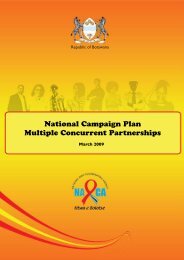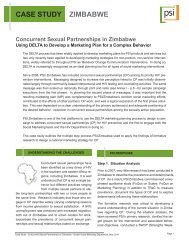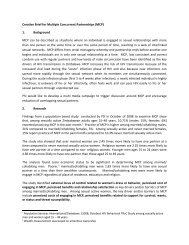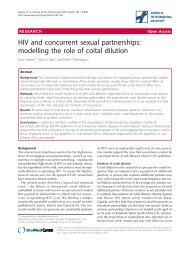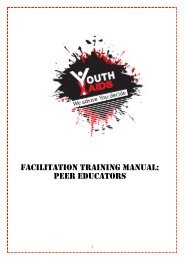O Icheke Game Guide for Field Officers - CONCURRENT SEXUAL ...
O Icheke Game Guide for Field Officers - CONCURRENT SEXUAL ...
O Icheke Game Guide for Field Officers - CONCURRENT SEXUAL ...
You also want an ePaper? Increase the reach of your titles
YUMPU automatically turns print PDFs into web optimized ePapers that Google loves.
<strong>Game</strong> 1<br />
SERIAL MONOGAMY<br />
Ask 12 people from the audience to come to the front.<br />
Ask 6 of them to stand in a line opposite the other 6<br />
participants. Now ask them to hold hands with the<br />
person in front of them. Each person is only linked to one<br />
other person.<br />
Ask a person from the end of the row to move to the<br />
beginning of the row. Everyone moves down a place to<br />
face a new partner. This is to signify a new relationship.<br />
Now identify someone in the group as HIV positive.<br />
Ask the participants ‘If this person is HIV positive,<br />
who else is at risk of contracting HIV?’<br />
Who else has the HIV positive person held<br />
hands with? ( holding hands symbolizes having<br />
sex)<br />
What about the first person they held hands<br />
with – is their current partner at risk?<br />
So, at the beginning of the game, one person was HIV<br />
positive but that one person has now managed to infect<br />
3 other people. So, a total of 4 of the 12 people are now<br />
infected with the virus. This type of relationship is called<br />
serial monogamy
<strong>Game</strong> 2<br />
MULTIPLE <strong>CONCURRENT</strong> PARTNERSHIPS<br />
Ask the 12 participants to now hold hands in a circle. Identify<br />
a person as being HIV positive. Now ask the group ‘Who<br />
else is at risk of contracting the virus?’<br />
The participants should identify the people that the HIV<br />
positive person is holding hands with as the ones at risk of<br />
contracting HIV.<br />
Ask the participants ‘Is anyone else at risk of<br />
contracting HIV?’<br />
Everyone in the circle should eventually identify themselves<br />
as HIV positive.<br />
So now all 12 people in the group are HIV positive. ‘What<br />
is the difference between the two games?’ The<br />
answer is concurrency. In this game, all participants are<br />
holding hands with 2 partners at the same time. There<strong>for</strong>e all<br />
12 people became infected, whereas in the first game, each<br />
person held hands with two people, but not at the same<br />
time. They had a break between partners so only 4 of the 12<br />
people became infected.<br />
Discussion guide<br />
-Do you know people in your community who<br />
are involved in these types of relationships?<br />
-What are some of the reasons <strong>for</strong> having multiple<br />
concurrent partnerships?<br />
-What are the benefits of being in a monogamous<br />
relationship?




